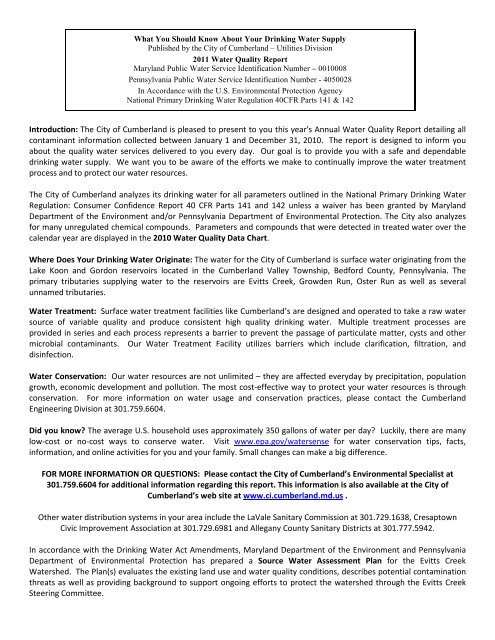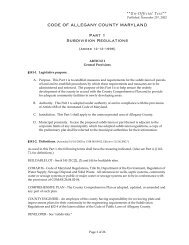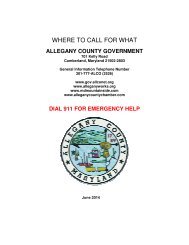Water Quality Report 2011 DRAFT 1 - Allegany County Government
Water Quality Report 2011 DRAFT 1 - Allegany County Government
Water Quality Report 2011 DRAFT 1 - Allegany County Government
You also want an ePaper? Increase the reach of your titles
YUMPU automatically turns print PDFs into web optimized ePapers that Google loves.
What You Should Know About Your Drinking <strong>Water</strong> Supply<br />
Published by the City of Cumberland – Utilities Division<br />
<strong>2011</strong> <strong>Water</strong> <strong>Quality</strong> <strong>Report</strong><br />
Maryland Public <strong>Water</strong> Service Identification Number – 0010008<br />
Pennsylvania Public <strong>Water</strong> Service Identification Number - 4050028<br />
In Accordance with the U.S. Environmental Protection Agency<br />
National Primary Drinking <strong>Water</strong> Regulation 40CFR Parts 141 & 142<br />
Introduction: The City of Cumberland is pleased to present to you this year's Annual <strong>Water</strong> <strong>Quality</strong> <strong>Report</strong> detailing all<br />
contaminant information collected between January 1 and December 31, 2010. The report is designed to inform you<br />
about the quality water services delivered to you every day. Our goal is to provide you with a safe and dependable<br />
drinking water supply. We want you to be aware of the efforts we make to continually improve the water treatment<br />
process and to protect our water resources.<br />
The City of Cumberland analyzes its drinking water for all parameters outlined in the National Primary Drinking <strong>Water</strong><br />
Regulation: Consumer Confidence <strong>Report</strong> 40 CFR Parts 141 and 142 unless a waiver has been granted by Maryland<br />
Department of the Environment and/or Pennsylvania Department of Environmental Protection. The City also analyzes<br />
for many unregulated chemical compounds. Parameters and compounds that were detected in treated water over the<br />
calendar year are displayed in the 2010 <strong>Water</strong> <strong>Quality</strong> Data Chart.<br />
Where Does Your Drinking <strong>Water</strong> Originate: The water for the City of Cumberland is surface water originating from the<br />
Lake Koon and Gordon reservoirs located in the Cumberland Valley Township, Bedford <strong>County</strong>, Pennsylvania. The<br />
primary tributaries supplying water to the reservoirs are Evitts Creek, Growden Run, Oster Run as well as several<br />
unnamed tributaries.<br />
<strong>Water</strong> Treatment: Surface water treatment facilities like Cumberland’s are designed and operated to take a raw water<br />
source of variable quality and produce consistent high quality drinking water. Multiple treatment processes are<br />
provided in series and each process represents a barrier to prevent the passage of particulate matter, cysts and other<br />
microbial contaminants. Our <strong>Water</strong> Treatment Facility utilizes barriers which include clarification, filtration, and<br />
disinfection.<br />
<strong>Water</strong> Conservation: Our water resources are not unlimited – they are affected everyday by precipitation, population<br />
growth, economic development and pollution. The most cost-effective way to protect your water resources is through<br />
conservation. For more information on water usage and conservation practices, please contact the Cumberland<br />
Engineering Division at 301.759.6604.<br />
Did you know The average U.S. household uses approximately 350 gallons of water per day Luckily, there are many<br />
low-cost or no-cost ways to conserve water. Visit www.epa.gov/watersense for water conservation tips, facts,<br />
information, and online activities for you and your family. Small changes can make a big difference.<br />
FOR MORE INFORMATION OR QUESTIONS: Please contact the City of Cumberland’s Environmental Specialist at<br />
301.759.6604 for additional information regarding this report. This information is also available at the City of<br />
Cumberland’s web site at www.ci.cumberland.md.us .<br />
Other water distribution systems in your area include the LaVale Sanitary Commission at 301.729.1638, Cresaptown<br />
Civic Improvement Association at 301.729.6981 and <strong>Allegany</strong> <strong>County</strong> Sanitary Districts at 301.777.5942.<br />
In accordance with the Drinking <strong>Water</strong> Act Amendments, Maryland Department of the Environment and Pennsylvania<br />
Department of Environmental Protection has prepared a Source <strong>Water</strong> Assessment Plan for the Evitts Creek<br />
<strong>Water</strong>shed. The Plan(s) evaluates the existing land use and water quality conditions, describes potential contamination<br />
threats as well as providing background to support ongoing efforts to protect the watershed through the Evitts Creek<br />
Steering Committee.
2010 <strong>Water</strong> <strong>Quality</strong> Data Chart<br />
Parameter Regulated<br />
Units<br />
Cumberland<br />
<strong>Water</strong><br />
Filtration<br />
Plant<br />
Ideal<br />
Goals<br />
(EPA's<br />
MCLG)<br />
Highest<br />
Level<br />
Allowed<br />
(EPA's<br />
MCL)<br />
Typical Sources of Contaminant<br />
Turbidity (max. monthly avg.) NTU 0.06 N/A TT Soil Run-Off<br />
Turbidity (max. reported) NTU 0.10 N/A 1.0 Soil Run-Off<br />
Total Trihalomethanes (avg) ppb 33 N/A 80 Byproduct of Drinking <strong>Water</strong> Chlorination<br />
Total Trihalomethanes (range) ppb 17 - 47 N/A 80 Byproduct of Drinking <strong>Water</strong> Chlorination<br />
Haloacetic Acids (avg) ppb 35 N/A 60 Byproduct of Drinking <strong>Water</strong> Chlorination<br />
Haloacetic Acids (range) ppb 27 - 42 N/A 60 Byproduct of Drinking <strong>Water</strong> Chlorination<br />
Total Coliform Bacteria P/A A 0 * Naturally Present in the Environment<br />
Copper ppm 0.23 1.3 1.3 (AL) Corrosion of Household Plumbing<br />
Lead ppb 1 0 15 (AL) Corrosion of Household Plumbing<br />
Nitrate ppm 0.577 10 10<br />
Barium ppm 0.036 2 2 Erosion of Natural Deposits<br />
Runoff from fertilizer use; Leaching from septic tanks,<br />
sewage; Erosion of natural deposits<br />
Gross Beta (2006) pCi/L 3.24 50 50 Decay of Natural and Man-Made Products<br />
Fluoride (average) ppm 0.97 4 4 Fluoride Addition<br />
Fluoride (max reported) ppm 1.39 4 4 Fluoride Addition<br />
Total Organic Carbon N/A met TT ** N/A TT Naturally Occurring in the Environment<br />
**Total Organic Carbon Treatment Technique (TT) compliance was achieved through a waiver obtained from Maryland Department of the Environment<br />
and Pennsylvania Department of Environmental Protection. As per CFR 141.135(a)(2) an alternative Step 2 TOC removal requirement was provided in<br />
consistency with all other National Primary Drinking <strong>Water</strong> Regulations.<br />
Chlorine (avg) ppm 0.2 MRDL 4 MRDL 4 <strong>Water</strong> Additive Used to Control Microbes<br />
Chlorine (range) ppm 0.0 - 2.0 MRDL 4 MRDL 4 <strong>Water</strong> Additive Used to Control Microbes<br />
Chloramines (avg) ppm 2.1 MRDL 4 MRDL 4 <strong>Water</strong> Additive Used to Control Microbes<br />
Chloramines (range) ppm 1.0 - 3.6 MRDL 4 MRDL 4 <strong>Water</strong> Additive Used to Control Microbes<br />
Unregulated<br />
pH (range) S.U. 6.80-7.67 N/A N/A Naturally Occurring in the Environment<br />
Sulfate (2007) ppm 11.3 N/A N/A Product of <strong>Water</strong> Treatment Process<br />
Chloride (2007) ppm 16 N/A N/A Product of <strong>Water</strong> Treatment Process<br />
Hardness ppm 76 N/A N/A Naturally Occurring in the Environment<br />
Sodium ppm 5.1 N/A N/A Naturally Occurring in the Environment<br />
Maximum Contaminant Level (MCL)<br />
Maximum Contaminant Level Goal (MCLG)<br />
Maximum Residual Disinfectant Level (MRDL)<br />
Action Level (AL)<br />
Treatment Technique (TT)<br />
Waiver, Variance, or Exception<br />
NTU – Nephelometric Turbidty<br />
ppb – Parts per billion<br />
P/A – Presence/Absence<br />
Definitions<br />
The highest level of a contaminant that is allows in drinking water. MCL's are set as<br />
close to the MCLG's as feasible using best available treatment technology<br />
The level of a contaminant in drinking water below which there is no known or<br />
expected risk to health. MCLG's allow for a margin of safety<br />
Set by the USEPA - is the highest level of a disinfectant allowed in drinking water<br />
The concentration of a contaminant which, if exceeded, triggers treatment or other<br />
requirements which a water system must follow<br />
A required process intended to reduce the level of a contaminant in drinking water<br />
State or EPA permission not to meet an MCL or a treatment technique under certain<br />
conditions<br />
pCi/L – Picocuries per liter (a measure of radioactivity)<br />
ppm – Parts per million<br />
S.U. – Standard Units<br />
*Not more than one (1) positive sample if less than 40 samples collected
General Drinking <strong>Water</strong> Information: Drinking water, including bottled water, may reasonably be expected to contain at<br />
least small amounts of some contaminants. The presence of contaminants does not necessarily indicate that water<br />
poses a health risk. More information about contaminants and potential health effects can be obtained by calling the<br />
Environmental Protection Agency's (EPA) Safe Drinking <strong>Water</strong> Hotline (800-426-4791).<br />
Some people may be more vulnerable to contaminants in drinking water than the general population. Immunocompromised<br />
persons such as persons with cancer undergoing chemotherapy, persons who have undergone organ<br />
transplants, people with HIV/AIDS or other immune system disorders, some elderly, and infants can be particularly at<br />
risk from infections. These people should seek advice about drinking water from their health care providers.<br />
EPA/Centers for Disease Control (CDC) guidelines on appropriate means to lessen the risk of infection by<br />
Cryptosporidium and other microbial contaminants are available from the Safe <strong>Water</strong> Drinking Hotline.<br />
In order to insure that tap water is safe to drink, EPA prescribes regulations which limit the amount of certain<br />
compounds in water provided by public water systems. The City of Cumberland’s water is treated in accordance with all<br />
State and Federal regulations. See the 2010 <strong>Water</strong> <strong>Quality</strong> Data Chart that summarizes water testing results for the<br />
2010 calendar year.<br />
Additional Information Regarding Lead: In 1992 EPA created new standards for acceptable levels of lead and copper in<br />
drinking water. Elevated levels of lead can cause serious health problems, especially for pregnant women and young<br />
children. Lead in drinking water is primarily from materials and components associated with service lines and home<br />
plumbing.<br />
The City of Cumberland – Utilities Division is responsible for providing high quality drinking water, but cannot control the<br />
variety of materials used in home plumbing components. When your water has been sitting for several hours, you can<br />
minimize the potential for lead exposure by flushing your tap for 30 seconds to 2 minutes before using water for<br />
drinking or cooking. If you are concerned about lead in your water, you may wish to have your water tested.<br />
Information on lead in drinking water, testing methods, and steps you can take to minimize exposure is available from<br />
the Safe Drinking <strong>Water</strong> Hotline or at http://www.epa.gov/safewater/lead.






